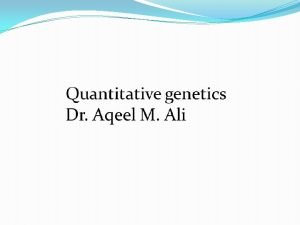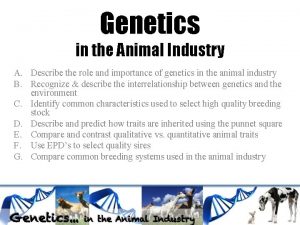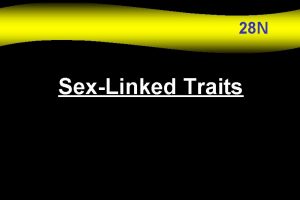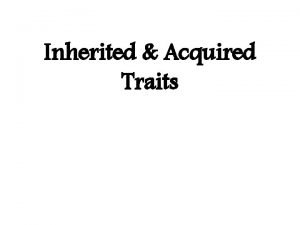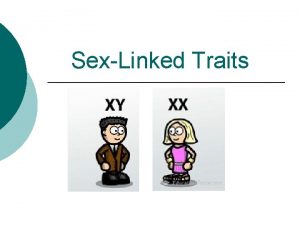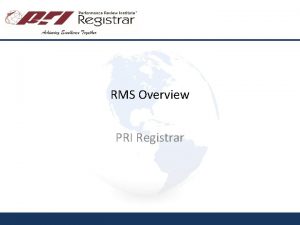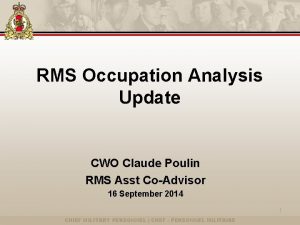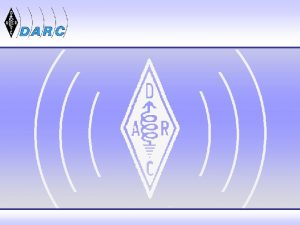Traits for species in Wo RMS EMODNET WP











- Slides: 11

Traits for species in Wo. RMS EMODNET WP 2. 2 Mark J. Costello Institute of Marine Science, Leigh Marine Laboratory, University of Auckland, New Zealand

WP 2. 2 = species attributes information 1. 2. Why? How? a) b) c) d) 3. What traits (vocabulary) Classification (relationships) Definition (glossary) Implementation Data analysis and publication

Why add traits to Wo. RMS? n Classification is a hypothesis for species relationships • • n n Taxonomic Environmental Geographic Ecological etc. . Data analysis needs consistent terminology Databases force standard terminology (fields) Databases may reveal new insights Each new trait (data field) has multiplier effect on potential data analyses

Need for standards n n Species names are the common currency and backbone for biodiversity informatics Species names have semantic problems –names can change over time But have taxonomic relationships and rules to minimise confusion Ecology is worse • diverse and uncontrolled terminology • highly context dependant

User needs n Food – fisheries, aquaculture n Pests – invasives, others n Health – HAB, sharks, toxicity n Conservation status BUT a species ‘status’ can change over time and place and so not ‘species’ traits

Kinds of traits 1. Numerical, e. g. body size in mm 2. Continuous, e. g. coastline, polygon 3. Categorical, e. g. predator Note 1 or 2 can = 3 but not the reverse

Relevance of traits Trait Relevance Taxonomic Depth Related species have similar traits so taxonomic relationships predict traits of related species Most studies are confined to a particular environment so this trait allows users to quickly isolate species of interest for their purpose. The most widely available variable to distinguish species habitat. Substratum A key physical factor determining benthic species habitat. Habitat Derived from environment, depth, and substratum. Habit Determines mode of dispersal and ecological role (e. g. habitat forming) in the ecosystem. Influence on abundance of other species. Environment Diet Feeding method Determines its diet and potential prey, and functional role in the ecosystem. Life-stage Most marine species traits change significantly at different life-stages. Body size Related to position in food web, species abundance, metabolic rates, and dispersal.

Trait prioritisation IN n n n n n Taxonomy Environment (Geography) Life-stage Depth Substratum Body size Diet Feeding method Habitat • depth, substratum, environment n OUT Unique to few taxa Temporal distribution Seascapes Ecosystems n OTHER ATTRIBUTE “status” n n n • Conservation • Economic

Proposed traits n n n Taxonomic Geography Environment Depth Substratum Habitat n n n Habit Diet Feeding method Life-stage Body size Phylum to Genus Marineregions. org, latitude – longitude Marine, brackish, freshwater, terrestrial Intertidal, subtidal, deep-sea (>500 m), max+min Pelagic, mud, sand, gravel, boulders, bedrock, biological = environment, depth + substratum Sessile, sedentary, mobile, solitary, aggregated, infauna, pelagic Carnivore, omnivore, herbivore, parasite, detrivore, plant, chemoautotroph Suspension, deposit, grazer, predator Adult, juvenile, larva, egg In mm

Other traits to consider n n Reproduction Fecundity Life-span (of each life-stage) Calcareous skeleton • ocean acidification, fossils n Guilds • e. g. ‘functional groups’ based on body size, habitat or diet; or can these be derived? Should we develop complete classification but only implement priority traits? Do we want ‘classes’ and a hierarchy of traits?

University of Auckland, north of New Zealand > 40 years daily sea temperature & weather data Variable biological data over time
 Emodnet bathymetry download
Emodnet bathymetry download Can plants be keystone species
Can plants be keystone species Qualitative traits vs quantitative traits
Qualitative traits vs quantitative traits Qualitative traits vs quantitative traits
Qualitative traits vs quantitative traits Qualitative traits vs quantitative traits
Qualitative traits vs quantitative traits Bunden form
Bunden form Nyckelkompetenser för livslångt lärande
Nyckelkompetenser för livslångt lärande Romarriket tidslinje
Romarriket tidslinje Datumr
Datumr Borstål, egenskaper
Borstål, egenskaper Verktyg för automatisering av utbetalningar
Verktyg för automatisering av utbetalningar Texter för hinduer tantra
Texter för hinduer tantra



